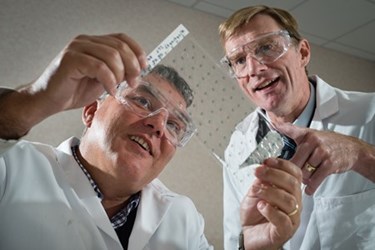World's First Ibuprofen Patch Delivers Pain Relief Through Skin

Researchers from the University of Warwick and medtech Medherant have patented a transdermal drug delivery patch that offers an extended release of ibuprofen for on-site pain relief. More efficient than oral medication and more consistent than topical gels, the ibuprofen patch is the first of its kind, and developers say the technology could be used in conjunction with other over-the-counter and prescription drugs in the future.
Nonsteroidal anti-inflammatory drugs (NSAIDs) like ibuprofen have been purchased over the counter and taken by mouth for decades, but recent research suggests that this method is not the most efficient. Swallowed medication is dispersed throughout the system and only part of it ends up at the site of inflammation.
In order to ensure that enough medication reaches the pain, dosages must be higher than necessary, which makes patients more susceptible to side effects, like stomach ulcers and kidney problems. While ibuprofen has been developed into a gel, researchers pointed out that it’s hard to control dosage with topical medications and they are not always convenient to apply.
The key to the Medherant technology, said researchers in a press release, is the amount of medication it can hold and the consistent and steady rate at which the drug is delivered. Scientists were able to incorporate 30 percent weight of the drug into a single-layer sticky polymer matrix, which adheres to the skin and consistently delivers pain relief for up to 12 hours.
The polymer technology was created by Bostik, a global adhesive specialist, which signed an exclusive licensing deal with Medherant for the development of transdermal drug delivery patches that Medherant claims are more durable and easier to remove than existing skin patches.
David Haddleton, research chemist at the University of Warwick and chief scientific officer at Medherant, commented that many pain relief patches currently on the market do not contain pain medication, only soothing heat elements. Therefore, the ibuprofen patch that he and his team developed was the first of its kind.
Haddleton said his team is looking beyond ibuprofen and hopes to incorporate other active agents into the polymer technology, which he said can be adjusted to suit the individual drug.
“We can improve the drug loading and stickiness of patches containing other active ingredients to improve patient comfort and outcome,” said Haddleton. Medherant CEO Nigel Davis added that the unique properties of their polymer open the field to drugs previously believed to be incompatible with patch delivery.
Michael Drues, president of Vascular Sciences, remarked in a recent MDO column that one third of all medical products currently in development are some combination of drug and device, and a 2013 report released by Transparency Market Research estimates that the market for drug-device combinations will reach $115.1 billion by 2019.
Davis said he expects the first of Medherant’s commercial products to be on the market within two years.
